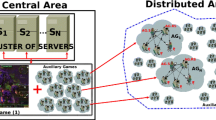Abstract
In a distributed MMOG (massively multiplayer online game) server architecture, the server nodes may become easily overloaded by the high demand from the players for state updates. Many works propose algorithms to distribute the load on the server nodes, but this load is usually defined as the number of players on each server, what is not an ideal measure. Also, the possible heterogeneity of the system is frequently overlooked. We propose a balancing scheme with two main goals: allocate load on server nodes proportionally to each one’s power and reduce the inter-server communication overhead, considering the load as the occupied bandwidth of each server. Four algorithms were proposed, from which ProGReGA is the best for overhead reduction and ProGReGA-KF is the most suited for reducing player migrations between servers. We also make a review of related works and some comparisons were made, where our approach performed better.













Similar content being viewed by others
References
Ahmed D, Shirmohammadi S (2008) A microcell oriented load balancing model for collaborative virtual environments. In: Proceedings of the IEEE conference on virtual environments, human-computer interfaces and measurement systems, VECIMS. IEEE, Piscataway, pp 86–91
Bettstetter C, Hartenstein H, Pérez-Costa X (2002) Stochastic properties of the random waypoint mobility model: epoch length, direction distribution, and cell change rate. In: Proceedings of the ACM international workshop on modeling analysis and simulation of wireless and mobile systems, vol 5. ACM, Atlanta, pp 7–14
Bezerra CEB, Cecin FR, Geyer CFR (2008) A3: a novel interest management algorithm for distributed simulations of mmogs. In: Proceedings of the IEEE/ACM international symposium on distributed simulation and real-time applications, DS-RT, vol 12. IEEE, Washington, DC, pp 35–42
Chen J, Wu B, Delap M, Knutsson B, Lu H, Amza C (2005) Locality aware dynamic load management for massively multiplayer games. In: Proceedings of the 10th ACM SIGPLAN symposium on principles and practice of parallel programming. ACM, New York, pp 289–300
Chen K, Huang P, Lei C (2006) Game traffic analysis: an MMORPG perspective. Comput Networks 50(16):3002–3023
De Vleeschauwer B, et al (2005) Dynamic microcell assignment for massively multiplayer online gaming. In: Proceedings of the ACM SIGCOMM workshop on network and system support for games, NetGames, vol 4. ACM, New York, pp 1–7
Duong T, Zhou S (2003) A dynamic load sharing algorithm for massively multiplayer online games. In: Proceedings of the 11th IEEE international conference on networks, pp 131–136
Feder T et al (1999) Complexity of graph partition problems. In: Proceedings of the ACM Symposium on Theory of Computing, STOC, vol 31. ACM, New York, pp 464–472
Feng W (2007) What’s next for networked games? http://www.thefengs.com/wuchang/work/. (NetGames 2007 keynote talk, nov. 2007)
Fiduccia C, Mattheyses R (1982) A linear-time heuristic for improving network partitions. In: Proceedings of the conference on design automation, vol 19. ACM, New York, pp 175–181
Hendrickson B, Leland R (1995) An improved spectral graph partitioning algorithm for mapping parallel computations. SIAM J Sci Comput 16(2):452–452
Karypis G, Kumar V (1998) A fast and high quality multilevel scheme for partitioning irregular graphs. SIAM J Sci Comput 20(1):359–392
Kernighan B, Lin S (1970) An efficient heuristic procedure for partitioning graphs. Bell Syst Tech J 49(2):291–307
Lee K, Lee D (2003)A scalable dynamic load distribution scheme for multi-server distributed virtual environment systems with highly-skewed user distribution. In: Proceedings of the ACM symposium on virtual reality software and technology. ACM, New York, pp 160–168
Lu F, Parkin S, Morgan G (2006) Load balancing for massively multiplayer online games. In: Proceedings of the 5th ACM SIGCOMM workshop on network and system support for games. ACM, New York
Microsoft (1997) Age of empires. http://www.microsoft.com/games/empires/
Acknowledgements
This work was supported by the National Research Council (CNPq) and by the Coordination of Improvement of Higher Education (CAPES), both Brazilian research funding agencies.
Author information
Authors and Affiliations
Corresponding author
Rights and permissions
About this article
Cite this article
Bezerra, C.E.B., Geyer, C.F.R. A load balancing scheme for massively multiplayer online games. Multimed Tools Appl 45, 263–289 (2009). https://doi.org/10.1007/s11042-009-0302-z
Published:
Issue Date:
DOI: https://doi.org/10.1007/s11042-009-0302-z




